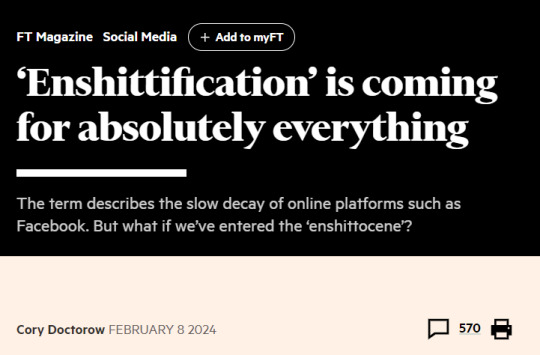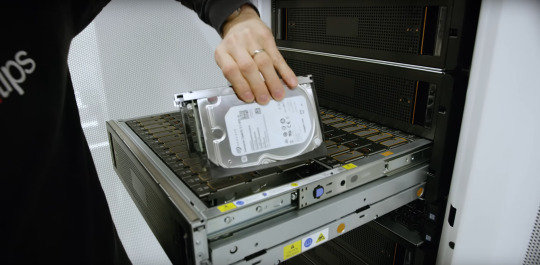#Big Data
Explore tagged Tumblr posts
Text

Fifty per cent of web users are running ad blockers. Zero per cent of app users are running ad blockers, because adding a blocker to an app requires that you first remove its encryption, and that’s a felony. (Jay Freeman, the American businessman and engineer, calls this “felony contempt of business-model”.) So when someone in a boardroom says, “Let’s make our ads 20 per cent more obnoxious and get a 2 per cent revenue increase,” no one objects that this might prompt users to google, “How do I block ads?” After all, the answer is, you can’t. Indeed, it’s more likely that someone in that boardroom will say, “Let’s make our ads 100 per cent more obnoxious and get a 10 per cent revenue increase.” (This is why every company wants you to install an app instead of using its website.) There’s no reason that gig workers who are facing algorithmic wage discrimination couldn’t install a counter-app that co-ordinated among all the Uber drivers to reject all jobs unless they reach a certain pay threshold. No reason except felony contempt of business model, the threat that the toolsmiths who built that counter-app would go broke or land in prison, for violating DMCA 1201, the Computer Fraud and Abuse Act, trademark, copyright, patent, contract, trade secrecy, nondisclosure and noncompete or, in other words, “IP law”. IP isn’t just short for intellectual property. It’s a euphemism for “a law that lets me reach beyond the walls of my company and control the conduct of my critics, competitors and customers”. And “app” is just a euphemism for “a web page wrapped in enough IP to make it a felony to mod it, to protect the labour, consumer and privacy rights of its user”.
11K notes
·
View notes
Text

8K notes
·
View notes
Text
Plus he stole everybody's data

173 notes
·
View notes
Text
What does AI actually look like?
There has been a lot of talk about the negative externalities of AI, how much power it uses, how much water it uses, but I feel like people often discuss these things like they are abstract concepts, or people discuss AI like it is this intangible thing that exists off in "The cloud" somewhere, but I feel like a lot of people don't know what the infrastructure of AI actually is, and how it uses all that power and water, so I would like to recommend this video from Linus Tech Tips, where he looks at a supercomputer that is used for research in Canada. To be clear I do not have anything against supercomputers in general and they allow important work to be done, but before the AI bubble, you didn't need one, unless you needed it. The recent AI bubble is trying to get this stuff into the hands of way more people than needed them before, which is causing a lot more datacenter build up, which is causing their companies to abandon climate goals. So what does AI actually look like?
First of all, it uses a lot of hardware. It is basically normal computer hardware, there is just a lot of it networked together.

Hundreds of hard drives all spinning constantly

Each one of the blocks in this image is essentially a powerful PC, that you would still be happy to have as your daily driver today even though the video is seven years old. There are 576 of them, and other more powerful compute nodes for bigger datasets.


The GPU section, each one of these drawers contains like four datacenter level graphics cards. People are fitting a lot more of them into servers now than they were then.

Now for the cooling and the water. Each cabinet has a thick door, with a water cooled radiator in it. In summer, they even spray water onto the radiator directly so it can be cooled inside and out.

They are all fed from the pump room, which is the floor above. A bunch of pumps and pipes moving the water around, and it even has cooling towers outside that the water is pumped out into on hot days.

So is this cool? Yes. Is it useful? Also yes. Anyone doing biology, chemistry, physics, simulations, even stuff like social sciences, and even legitimate uses of analytical ai is glad stuff like this exists. It is very useful for analysing huge datasets, but how many people actually do that? Do you? The same kind of stuff is also used for big websites with youtube. But the question is, is it worth building hundreds more datacenters just like this one, so people can automatically generate their emails, have an automatic source of personal attention from a computer, and generate incoherent images for social media clicks? Didn't tech companies have climate targets, once?
110 notes
·
View notes
Text









218 notes
·
View notes
Text
The almost overnight surge in electricity demand from data centers is now outstripping the available power supply in many parts of the world, according to interviews with data center operators, energy providers and tech executives. That dynamic is leading to years-long waits for businesses to access the grid as well as growing concerns of outages and price increases for those living in the densest data center markets. The dramatic increase in power demands from Silicon Valley’s growth-at-all-costs approach to AI also threatens to upend the energy transition plans of entire nations and the clean energy goals of trillion-dollar tech companies. In some countries, including Saudi Arabia, Ireland and Malaysia, the energy required to run all the data centers they plan to build at full capacity exceeds the available supply of renewable energy, according to a Bloomberg analysis of the latest available data. By one official estimate, Sweden could see power demand from data centers roughly double over the course of this decade — and then double again by 2040. In the UK, AI is expected to suck up 500% more energy over the next decade. And in the US, data centers are projected to use 8% of total power by 2030, up from 3% in 2022, according to Goldman Sachs, which described it as “the kind of electricity growth that hasn’t been seen in a generation.”
21 June 2024
673 notes
·
View notes
Text
#black women#beautiful model#beautiful women#beauttiful girls#black beauty#male beauty#beautiful body#a date with death#big data#lean#self love#off the hook#beautifull#natural body
34 notes
·
View notes
Text
The latest, AI-dedicated server racks contain 72 specialised chips from manufacturer Nvidia. The largest “hyperscale” data centres, used for AI tasks, would have about 5,000 of these racks. And as anyone using a laptop for any period of time knows, even a single chip warms up in operation. To cool the servers requires water – gallons of it. Put all this together, and a single hyperscale data centre will typically need as much water as a town of 30,000 people – and the equivalent amount of electricity. The Financial Times reports that Microsoft is currently opening one of these behemoths somewhere in the world every three days. Even so, for years, the explosive growth of the digital economy had surprisingly little impact on global energy demand and carbon emissions. Efficiency gains in data centres—the backbone of the internet—kept electricity consumption in check. But the rise of generative AI, turbocharged by the launch of ChatGPT in late 2022, has shattered that equilibrium. AI elevates the demand for data and processing power into the stratosphere. The latest version of OpenAI’s flagship GPT model, GPT-4, is built on 1.3 trillion parameters, with each parameter describing the strength of a connection between different pathways in the model’s software brain. The more novel data that can be pushed into the model for training, the better – so much data that one research paper estimated machine learning models will have used up all the data on the internet by 2028. Today, the insatiable demand for computing power is reshaping national energy systems. Figures from the International Monetary Fund show that data centres worldwide already consume as much electricity as entire countries like France or Germany. It forecasts that by 2030, the worldwide energy demand from data centres will be the same as India’s total electricity consumption.
30 May 2025
80 notes
·
View notes
Text
Each time you search for something like “how many rocks should I eat” and Google’s AI “snapshot” tells you “at least one small rock per day,” you’re consuming approximately three watt-hours of electricity, according to Alex de Vries, the founder of Digiconomist, a research company exploring the unintended consequences of digital trends. That’s ten times the power consumption of a traditional Google search, and roughly equivalent to the amount of power used when talking for an hour on a home phone. (Remember those?) Collectively, De Vries calculates that adding AI-generated answers to all Google searches could easily consume as much electricity as the country of Ireland.
[...]
This insatiable hunger for power is slowing the transition to green energy. When the owner of two coal-fired power plants in Maryland filed plans to close last year, PJM asked them to keep running till at least 2028 to ensure grid reliability. Meanwhile, AI is also being used to actively increase fossil fuel production. Shell, for example, has aggressively deployed AI to find and produce deep-sea oil. “The truth is that these AI models are contributing in a significant way to climate change, in both direct and indirect ways,” says Tom McBrien, counsel for the Electronic Privacy Information Center, a digital policy watchdog. Even before Google’s AI integration this spring, the average internet user’s digital activity generated 229 kilograms of carbon dioxide a year. That means the world’s current internet use already accounts for about 40 percent of the per capita carbon budget needed to keep global warming under 1.5 degrees Celsius.
20 June 2024
#ai#artificial intelligence#google#big data#energy#internet#climate change#destroy your local AI data centre
237 notes
·
View notes
Text
Surrender to my boobs and dick, you will never want to leave a❤

#trans gender#transgender#transsexual#trans man#trans girl#transgiri#trans woman#trans guy#trans pride#trans goddess#transgirl#transfem#typography#big round butt#eat my butt#gay bulge#gay#gay men#trans g#girl butts#great butt#sissy domination#sissy caged#humiliation sissy#dick grayson#bisexual#bikni girls#beauttiful girls#big data#black and white
29 notes
·
View notes
Text

Once you go down the Thiel rabbit hole you will understand why so many are concerned about his connection to Trump, JD Vance and Elon Musk.
This meme barely scratches the surface.
Learn More: https://thefreethoughtproject.com/deep-state/peter-thiel-from-gaza-ai-war-criminal-to-white-house-puppet-master
#TheFreeThoughtProject
#the free thought project#tftp#peter thiel#palantir#big tech#technocrats#big data#pre crimes#paypal#billionaire#bilderberg
74 notes
·
View notes